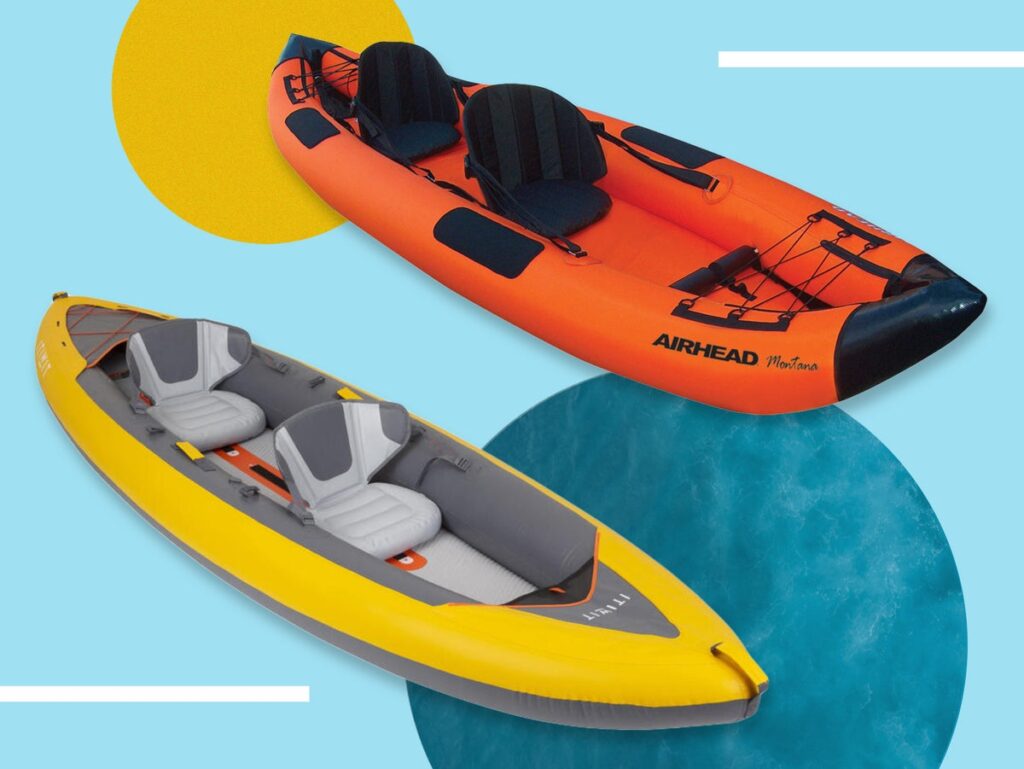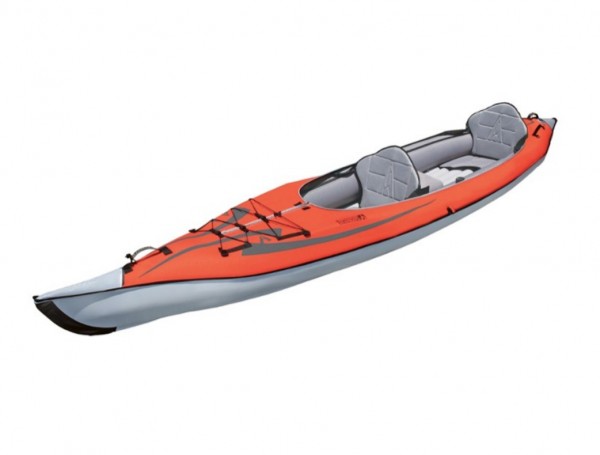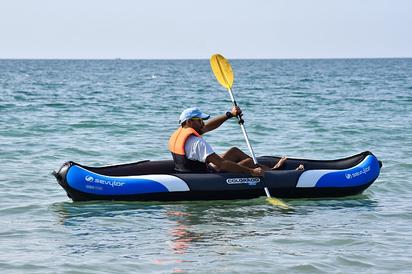
Welcome! In this article, we’re going to explore the effectiveness of inflatable kayaks and answer the question: do they really work? We’ll discuss the advantages and disadvantages of using inflatable kayaks, and provide some tips on how to choose the right one for you. By the end of this article, you will have a better understanding of whether or not inflatable kayaks are a suitable option for your kayaking adventures.
Firstly, let’s talk about whether inflatable kayaks actually work. The short answer is yes! Inflatable kayaks have come a long way in terms of design and durability, making them a reliable option for water enthusiasts. They are made with tough materials that can withstand rough waters and provide stability during your kayak trips. However, it is important to note that they may not perform as well in extreme conditions or on fast-moving rivers. With proper care and maintenance, inflatable kayaks can be a practical and enjoyable choice for both beginners and experienced kayakers alike.

Introduction to Inflatable Kayaks
When it comes to water sports and outdoor adventures, kayaking is a popular choice for many enthusiasts. However, traditional hard-shell kayaks can be bulky and difficult to transport, making them less accessible for those who want to explore different water bodies. This is where inflatable kayaks come in. Inflatable kayaks have gained popularity in recent years due to their portability, ease of use, and overall effectiveness. In this article, we will delve into the world of inflatable kayaks, exploring their history, advantages, disadvantages, design and construction, performance and durability, safety considerations, versatility and portability, performance in different water conditions, comparison with hard-shell kayaks, maintenance and care, buying guide, and finally, conclude with a summary of their effectiveness and some recommendations.
History of Inflatable Kayaks
Inflatable kayaks have a fascinating history that dates back several decades. The first inflatable kayaks were developed in the mid-20th century, primarily for military and rescue purposes. They were designed to be lightweight, easily transportable, and capable of withstanding challenging water conditions. Over the years, advancements in materials and construction techniques have led to the development of inflatable kayaks that are not only durable but also excel in performance.
Advantages of Inflatable Kayaks
Inflatable kayaks offer several advantages over their hard-shell counterparts. One of the primary advantages is their portability. Unlike hard-shell kayaks, inflatable kayaks can be deflated, rolled up, and stored in a compact carrying bag. This makes them ideal for those who have limited storage space or for those who want to take their kayak on vacations or camping trips.
Another advantage of inflatable kayaks is their ease of use. Inflating an inflatable kayak is a simple and quick process, usually requiring a manual or electric pump. Once inflated, they provide a stable and comfortable platform for kayaking. Additionally, inflatable kayaks are lightweight, making them easier to carry, launch, and maneuver in the water.
Disadvantages of Inflatable Kayaks
While inflatable kayaks have numerous advantages, they also have a few disadvantages to consider. One of the main concerns is punctures or leaks. Although modern inflatable kayaks are made from durable materials, they can still be susceptible to punctures from sharp objects. However, most inflatable kayaks are designed with multiple air chambers, meaning that even if one chamber is punctured, the kayak will still remain afloat.
Another disadvantage is the potential for decreased speed and efficiency compared to hard-shell kayaks. Inflatable kayaks generally have a wider design and a less streamlined shape, which can result in slightly slower speeds. However, for recreational and casual use, this slight decrease in speed may not be a significant concern.
Design and Construction of Inflatable Kayaks
Materials Used in Inflatable Kayaks
Inflatable kayaks are typically constructed using a combination of durable materials, such as PVC or Hypalon. PVC (Polyvinyl Chloride) is the most common material used, known for its strength, flexibility, and resistance to wear and tear. Hypalon, on the other hand, is a synthetic rubber material known for its excellent resistance to UV rays and chemicals. Both materials offer excellent durability and are suitable for different water conditions.
Types of Inflatable Kayak Designs
Inflatable kayaks come in various designs to cater to different preferences and purposes. The most common designs include sit-on-top, sit-inside, and tandem kayaks. Sit-on-top kayaks are popular for their ease of use and stability, making them suitable for beginners and recreational kayakers. Sit-inside kayaks, on the other hand, provide more protection from water splashes and are preferred by advanced kayakers. Tandem kayaks are designed to accommodate two people and are perfect for kayaking with a partner or a furry friend.
Features and Components of Inflatable Kayaks
Inflatable kayaks are equipped with various features and components to enhance their performance and user experience. These may include adjustable seats and footrests to ensure comfort during long paddling sessions, multiple air chambers for added safety, bungee cords and storage compartments for carrying gear and supplies, and durable grab handles for easy transportation.
Performance and Durability
Stability and Maneuverability of Inflatable Kayaks
One of the key factors contributing to the effectiveness of inflatable kayaks is their stability and maneuverability. Due to their wider design and buoyancy, inflatable kayaks offer excellent stability, making them ideal for beginners and recreational kayakers. Maneuverability is also a strong point for inflatable kayaks, as their lightweight construction and flexible materials allow for easy turns and precise control in the water.
Speed and Efficiency of Inflatable Kayaks
While inflatable kayaks may not match the speed and efficiency of hard-shell kayaks, they still offer respectable performance on the water. Their wider design and increased buoyancy translate into stability, which can compensate for slightly slower speeds. Additionally, inflatable kayaks can handle different water conditions, from calm lakes to mild rapids, making them versatile companions for various kayaking adventures.
Durability and Resistance to Wear
Modern inflatable kayaks are built to withstand the rigors of kayaking and are highly durable. The materials used in their construction are designed to resist punctures, abrasions, UV rays, and water exposure. It is important to note that proper care, maintenance, and avoiding sharp objects are essential to prolong the lifespan of an inflatable kayak. Regular inspections, cleaning, and drying are recommended after each use to ensure the kayak remains in good condition.
Safety Considerations
Buoyancy and Stability in Inflatable Kayaks
Safety is a crucial aspect to consider when using inflatable kayaks. One of the key safety features of inflatable kayaks is their buoyancy. Inflatable kayaks are designed with multiple air chambers, which means that even if one chamber is punctured, the kayak will still remain afloat. This provides an added level of safety and peace of mind for kayakers.
Stability is also an important factor for safety. Inflatable kayaks generally have a wider design, which enhances their stability in the water. This makes them less likely to tip over, even when navigating through waves or currents. However, it is still important to practice proper kayaking techniques and to always wear a personal flotation device (PFD) for added safety.
Safety Features and Equipment
Inflatable kayaks are equipped with various safety features and equipment to ensure a safe kayaking experience. This includes grab handles for easy entry and exit, paddle holders to secure the paddles when not in use, and attachment points for securing gear or a PFD. In addition to these features, it is essential to carry essential safety equipment, such as a PFD, a whistle, a first aid kit, and a kayak-specific rescue or towing system.
Risk Factors and Precautions
While inflatable kayaks are generally safe, it is important to be aware of the potential risks and take necessary precautions. One of the main risks is capsizing or falling overboard. To minimize this risk, it is recommended to familiarize yourself with proper kayaking techniques, maintain proper balance, and avoid sudden movements. Additionally, being aware of weather conditions, water currents, and potential hazards in the water is crucial for a safe kayaking experience.

Versatility and Portability
Ease of Transport and Storage
One of the major advantages of inflatable kayaks is their ease of transport and storage. Unlike bulky hard-shell kayaks, inflatable kayaks can be deflated and rolled up into a compact size, making them easy to transport in a car or even on public transportation. This portability allows kayakers to explore different water bodies without the constraints of traditional kayaks.
Storage is another area where inflatable kayaks excel. When deflated, they can be stored in a small carrying bag, requiring little space in a garage, closet, or even a small apartment. This makes them an attractive option for those with limited storage space.
Suitability for Different Water Conditions
Inflatable kayaks are suitable for a wide range of water conditions, from calm lakes and ponds to mild rivers and even coastal areas. They handle gentle waves and currents with ease, providing a stable and enjoyable kayaking experience. However, it is important to note that inflatable kayaks may not be suitable for extreme white-water rafting or heavy surf conditions, as their design and construction are optimized for recreational kayaking.
Compatibility with Accessories
One of the great things about inflatable kayaks is their compatibility with various accessories. Most inflatable kayaks come with attachment points or bungee cords, allowing users to attach accessories such as fishing rod holders, gear racks, or a GPS device. These accessories can enhance the functionality and versatility of the kayak, catering to different interests and activities.
Performance in Different Water Conditions
Kayaking in Calm Waters
Inflatable kayaks are well-suited for kayaking in calm waters such as lakes, ponds, or slow-moving rivers. Their stability and ease of maneuverability make them perfect for leisurely paddling, fishing, or simply enjoying the tranquility of the water. In calm waters, inflatable kayaks provide a comfortable and stable platform, allowing kayakers to relax and take in the surroundings.
Handling Rough Waters and Rapids
While inflatable kayaks may not be designed for extreme white-water rafting or heavy rapids, they can handle mild to moderate whitewater conditions with skill and stability. The wider design and buoyancy of inflatable kayaks help them navigate through rapids with ease while providing a stable and secure paddling experience. It is important to choose an inflatable kayak specifically designed for rapids and to wear appropriate safety gear and equipment in these conditions.
Inflatable Kayaks for Sea or Ocean Use
Inflatable kayaks can also be used in sea or ocean environments, although careful consideration and preparation are necessary. When venturing into open waters, it is recommended to choose an inflatable kayak with a sleeker design and a higher level of buoyancy. Additionally, weather conditions, tides, and currents should be closely monitored to ensure a safe and enjoyable kayaking experience. It is also essential to carry the necessary safety equipment, such as a marine VHF radio and flares, and to be aware of potential risks associated with open water kayaking.

Comparing Inflatable Kayaks with Hard-Shell Kayaks
Inflatable kayaks and hard-shell kayaks each have their own set of advantages and disadvantages. Understanding these differences can help you determine which option is right for your needs and preferences.
Pros and Cons of Inflatable Kayaks
Pros of inflatable kayaks include their portability, ease of storage, and affordability compared to hard-shell kayaks. They are also versatile and suitable for various water conditions. However, they may have slightly slower speeds and require more maintenance and care to prevent punctures or leaks.
Pros and Cons of Hard-Shell Kayaks
Hard-shell kayaks offer excellent speed and efficiency, making them ideal for avid kayakers and those seeking high-performance watercraft. They are also generally more durable and resistant to punctures. However, hard-shell kayaks can be bulky and difficult to transport, requiring a roof rack or trailer for transportation. They also require more storage space and may be more expensive than inflatable kayaks.
Which Option is Right for You?
Determining whether an inflatable kayak or a hard-shell kayak is the right choice for you depends on your specific needs and preferences. If portability, ease of storage, and affordability are your main priorities, an inflatable kayak may be the best option. On the other hand, if speed, performance, and durability are more important to you, a hard-shell kayak might be the better choice. It is important to carefully consider your kayaking requirements and budget before making a decision.
Maintenance and Care
Cleaning and Drying Inflatable Kayaks
Proper cleaning and drying are essential to maintain the condition and longevity of an inflatable kayak. After each use, the kayak should be rinsed with fresh water to remove any salt, sand, or debris. A mild soap or kayak-specific cleaner can be used for more thorough cleaning. After cleaning, the kayak should be completely dried before storage to prevent mold or mildew growth. Ensure that all air chambers, valves, and components are dry before deflating and rolling up the kayak.
Patch and Repair Techniques
In the unfortunate event of a puncture or leak, it is important to know how to patch and repair an inflatable kayak. Most inflatable kayaks come with a repair kit that includes patches and adhesive. To repair a puncture, clean and dry the damaged area, apply the adhesive, and firmly press the patch onto the hole. Allow the adhesive to cure according to the manufacturer’s instructions before inflating the kayak. It is recommended to practice patching and repairing techniques in a controlled environment before heading out on the water.
Inflatable Kayak Maintenance Tips
To keep your inflatable kayak in top condition, there are a few maintenance tips to follow. Firstly, always check the kayak for any signs of wear, punctures, or leaks before each use. This includes inspecting the seams, valves, and air chambers. Secondly, store the kayak in a cool, dry place away from direct sunlight or extreme temperatures. Avoid storing the kayak in a tightly rolled-up position for extended periods, as this can cause creases or damage to the material. Lastly, follow the manufacturer’s instructions and recommendations for proper care and maintenance.

Buying Guide for Inflatable Kayaks
Factors to Consider Before Buying
When buying an inflatable kayak, there are several factors to consider to ensure you choose the right kayak for your needs. These factors include the intended use of the kayak (recreational, fishing, whitewater), the capacity and size of the kayak, the weight and portability, the material and construction quality, the stability and maneuverability, and the compatibility with accessories. Additionally, it is important to set a budget and research different brands and models to find the best value for your money.
Popular Brands and Models
There are numerous reputable brands that produce high-quality inflatable kayaks. Some popular brands include Advanced Elements, Sea Eagle, Intex, and Sevylor. Each brand offers various models with different features and designs to cater to different preferences and budgets. It is recommended to read customer reviews, watch product videos, and seek recommendations from experienced kayakers to narrow down your options and choose the best brand and model for your needs.
Price Range and Value for Money
Inflatable kayaks are available at a wide range of price points, depending on the brand, model, and features. Entry-level inflatable kayaks can start from around $100, while higher-end models with advanced features and materials can cost several hundred dollars. It is important to consider the value for money when making a purchase. Look for kayaks that offer a good balance between price and quality, prioritizing durability, performance, and customer satisfaction.
Conclusion
Inflatable kayaks have undoubtedly revolutionized the kayaking industry, offering a multitude of advantages over traditional hard-shell kayaks. From their portability and ease of use to their versatility and performance, inflatable kayaks have proven to be effective watercraft for various water conditions and activities. By understanding their history, advantages, disadvantages, design and construction, performance and durability, safety considerations, versatility and portability, performance in different water conditions, comparison with hard-shell kayaks, maintenance and care, and considering the buying guide, you can make an informed decision when choosing an inflatable kayak. Whether you’re a beginner looking to explore calm lakes or an experienced kayaker seeking adventure in mild rapids, inflatable kayaks provide an excellent option for enjoyable water experiences. So grab your paddle, inflate your kayak, and embark on endless aquatic adventures with confidence and ease.








